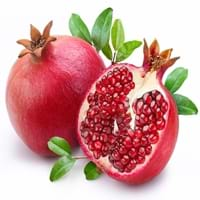Health Benefits
Anti-oxidant properties, Boosts immune system, Skin rejuvenation, Strengthening of bones
Cancer prevention, Heart care, Helps in cartilage regeneration, Improves stomach health, Increase in haemoglobin, Increases metabolic rate, Prevents constipation
General Benefits
Antiseptic properties, Cures headache, Removes waste from kidney
Boosts immune system, Controls blood pressure, Controls blood sugar levels, Digestive aid, Maintains healthy cholesterol level
Skin Benefits
Hydrates skin
Anti-aging benefits, Skin rejuvenation, Treatment of acne
Hair Benefits
Good conditioner
Prevents hair loss, Promotes longer and healthier hair, Treatment of dandruff
Allergy Symptoms
Chest pains, Rhinitis, Wheezing
Abdominal pains, Anaphylaxis, Itching
Side Effects
Unknown
Allergic reaction, Cold, Breathing difficulty, Irritation, Swelling
Best Time to Eat
As a snack in the late afternoon, Don't consume at night and before bed, Eat the fresh ones, avoid mixing with any other foods, don't eat after meal., Morning time (before lunch)
Best if taken as a breakfast (or empty stomach), As a snack in the late afternoon, Eat the fresh ones, avoid mixing with any other foods, don't eat after meal., Morning time (before lunch)
Vitamin B5 (Pantothenic Acid)
Vitamin C (Ascorbic Acid)
Vitamin K (Phyllochinone)
Phytosterol
Not Available
Calories in Fresh Fruit with Peel
Not Available
Calories in Fresh Fruit without Peel
Not Available
Calories in Frozen Form
Not Available
Calories in Canned Form
Not Available
Calories in Jam
Not Available
Calories in Pie
Not Available
Type
Tree fruit, Tropical
Tree fruit
Season
Early summer, Early winter, Late fall, Late spring
Autumn
Varieties
Rongrien, Chompu, Rapiah, Bingjai and Lebak Bulus
Balegal, Crab, Cloud, Francis, Freshman and Granada
Color
Coral red, Yellow
Dark red, Light pink-red
Inside Color
Greyish-white
Red
Taste
Sour, Sweet
Juicy, Sweet
Origin
Unknown
India, Iran
Soil Type
Clay, Loam
Clay, Sand
Climatic Conditions
Humid
Cold, Dry, Hot
Facts about
- Oils extracted from its seeds is used to make soaps and candles.
- 'Rambut' means hairy in Malay.
- It makes the best hair mask.
- Seeds are edible and healthy too.
- Pomegranate means apple with many seeds.
- It was called as the “apple of Grenada” in early English.
- In Hinduism, this fruit symbolizes prosperity and fertility.
- Pomegranate trees can live upto 200 years.
Top Producer
Thailand
Iran
Other Countries
Africa, India, Indonesia, Malaysia, Philippines, Sri Lanka
Africa, India, Middle east, Pakistan
Top Importer
Singapore
Europe
Top Exporter
Thailand
India
Botanical Name
Nephelium lappaceum
Punica granatum
Synonym
Rambota
Punica malus
Subkingdom
Tracheobionta
Tracheobionta
Division
Tracheophyta
Magnoliophyta
Class
Magnoliopsida
Magnoliopsida
Order
Sapindales
Myrtales
Family
Sapindaceae
Lythraceae
Species
N. lappaceum
P. granatum
Generic Group
Not Available
Pomegranate
Difference Between Rambutan and Pomegranate
We might think that Rambutan and Pomegranate are similar with respect to nutritional value and health benefits. But the nutrient content of both fruits is different. Rambutan and Pomegranate Facts such as their taste, shape, color, and size are also distinct. The difference between Rambutan and Pomegranate is explained here.
The amount of calories in 100 gm of fresh Rambutan and Pomegranate with peel is 69.00 kcal and Not Available and the amount of calories without peel is Not Available and 83.00 kcal respectively. Thus, Rambutan and Pomegranate belong to and category.These fruits might or might not differ with respect to their scientific classification. The order of Rambutan and Pomegranate is Sapindales and Myrtales respectively. Rambutan belongs to Sapindaceae family and Pomegranate belongs to Lythraceae family. Rambutan belongs to Nephelium genus of N. lappaceum species and Pomegranate belongs to Punica genus of P. granatum species. Beings plants, both fruits belong to Plantae Kingdom.









